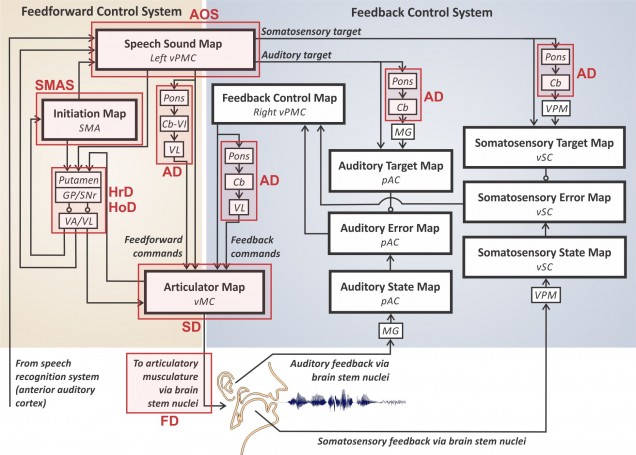Research in Speech Disorders
The DIVA and GODIVA models were developed with the goal of providing mechanistic interpretations for neurological disorders of speech production. In collaborations with researchers in the communication disorders, we have performed a number of modeling and experimental studies to provide insights into speech disorders including stuttering, dysarthria, apraxia of speech, pediatric motor speech disorders, speech impairments in autism, and locked-in syndrome (see Publications below). The schematic that follows indicates speech disorders associated with damage to components of the DIVA model.

Locations of damage associated with speech motor disorders (adapted from Guenther, 2016, Chapter 10). AD: ataxic dysarthria. AOS: apraxia of speech. FD: flaccid dysarthria. HoD: hypokinetic dysarthria. HrD: hyperkinetic dysarthria. SD: spastic dysarthria. SMAS: supplementary motor area syndrome.
Publications
- Guenther, F.H. (2016). Neural Control of Speech. Cambridge, MA: MIT Press.
- Sitek, K.R., Cai, S., Beal, D.S., Perkell, J.S., Guenther, F.H., and Ghosh, S.S. (2016). Decreased cerebellar-orbitofrontal connectivity correlates with stuttering severity: Whole-brain functional and structural connectivity associations with persistent developmental stuttering. Frontiers in Human Neuroscience, 10, article 190.
- Maas, E., Mailend, M., and Guenther, F.H. (2015). Feedforward and feedback control in Apraxia of Speech (AOS): Effects of noise masking on vowel production. Journal of Speech, Language, and Hearing Disorders, 58, pp. 185-200.
- Cai, S., Tourville, J.A., Beal, D.S., Perkell, J.S., Guenther, F.H. and Ghosh, S.S. (2014). Diffusion imaging of cerebral white matter in persons who stutter: evidence for network-level anomalies. Frontiers in Human Neuroscience, 8, pp. 54.
- Cai, S., Beal, D.S., Ghosh, S.S., Guenther, F.H., and Perkell, J.S. (2014) Impaired timing adjustments in response to time-varying auditory perturbation during connected speech production in persons who stutter. Brain and Language, 129, pp. 24-29. PMCID:PMC3947674
- Terband, H., Maassen, B., Guenther, F.H., and Brumberg, J. (2014) Auditory-motor interactions in pediatric motor speech disorders: Neurocomputational modeling of disordered development. Journal of Communication Disorders, 47, pp. 17-33. PMCID:PMC3971843
- Civier, O., Bullock, D., Max, L., and Guenther, F.H. (2013). Computational modeling of stuttering caused by impairments in a basal ganglia thalamo-cortical circuit involved in syllable selection and initiation. Brain and Language, 126, pp.263-278. PMCID: PMC3775364
- Peeva, M., Tourville, J.A., Agam, Y., Holland, B., Manoach, D.S., and Guenther, F.H. (2013) White matter impairment in the speech network of individuals with autism spectrum disorder. NeuroImage: Clinical, 3, pp. 234-241. PMCID: PMC3815014
- Mody, M., Manoach, D.S., Guenther, F.H., Tenet, K., Bruno, K.A., McDougle, C.J., and Stigler, K.A. (2013). Speech and language in autism spectrum disorder: A view through the lens of behavior and brain imaging. Neuropsychiatry, 3, pp. 223-232.
- Cai, S., Beal, D.S., Ghosh, S.S., Tiede M.K., Guenther, F.H., and Perkell, J.S. (2012). Weak responses to auditory feedback perturbation during articulation in persons who stutter: Evidence for abnormal auditory-motor transformation. PLoS One, 7 (7), pp. e41830+. PMCID: PMC3402433
- Civier, O., Tasko, S., Guenther, F.H. (2010) Overreliance on auditory feedback may lead to sound/syllable repetitions: Simulations of stuttering and fluency-inducing conditions with a neural model of speech production. Journal of Fluency Disorders, 35 (3), pp. 246-279. PMCID:PMC2939043
- Guenther, F.H., Brumberg, J.S., Wright, E.J., Nieto-Castanon, A., Tourville, J.A., Panko, M., Law, R., Siebert, S.A., Bartels, J.L., Andreasen, D.S., Ehirim, P., Mao, H., and Kennedy, P.R. (2009). A wireless brain-machine interface for real-time speech synthesis. PLoS ONE, 4 (12), e8218. PMCID:PMC2784218
- Terband, H., Maassen, B., Guenther, F.H., and Brumberg, J.S. (2009) Computational Neural Modeling of Speech Mortor Control in Childhood Apraxia of Speech (CAS). Journal of Speech, Language and Hearing Research, 52, pp. 1595-1609.
- Max, L., Guenther, F.H., Gracco, V.L., Ghosh, S.S., and Wallace, M.E. (2004) Unstable or insufficiently activated internal models and feedback-biased motor control as sources of dysfluency: A theoretical model of stuttering. Contemporary Issues in Communication Science and Disorders, 31, pp. 105-122.